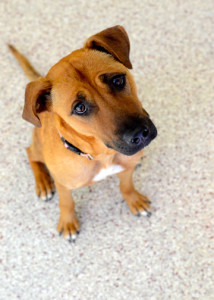Set Your Goals for Successful Dog Training
Does your dog have some behaviors that you’d like to improve on? Would you like to increase your own skills as a trainer to help your dog’s long term behavior? With both New Year’s dog training resolutions and National Train Your Dog Month, January is the ideal time to re-evaluate your dog’s skills and your skills as a trainer to have a better life together. Where should you start?
What’s the goal?
First, it is necessary to realistically evaluate what dog behaviors you want to change and more importantly, describe in detail what you want to teach your dog to do instead. So often, we focus on the negatives and what we don’t like which makes resolving any issue seem daunting. Your focus should be detailing specific goal behaviors you want to teach to replace the behaviors you don’t like.
For example, if your dog jumps up on visitors, what could your dog do instead? For many dogs, keeping four paws on the ground or learning to stay calm and hold a seated position for petting are great goals. There’s also nothing wrong with a more complex goal. Perhaps your dog’s goal behaviors could be to sit on a mat while you answer the door, to remain on the mat and wait for a release cue, and then sit calmly for petting by your guests. Whatever your
Plan and evaluate
Next, you must create a step by step plan for how to teach your dog all the necessary skills to accomplish the goal behaviors. Look at each behavior required to reach your goal and what your dog’s current ability is. If you dog doesn’t go to a mat, doesn’t know how to sit, or can’t hold a sit when they get excited, you must teach those individual skills first in order to reach the goal behaviors. Set up small goals along the way to help keep you motivated and measuring success.
Successful training involves clarity and consistency. So evaluate your ability to communicate effectively and reinforce your dog meaningfully. Make sure that you are using a clear reward marker, such as “Yes” or using a clicker to help your dog understand exactly what you want. Does your dog find the rewards you are using really motivating? For many dogs, food treats are a highly valued resource, but don’t overlook real life rewards that can be incorporated into your reward based repertoire such as attention from new people or access to a new/favorite toy.
Go back to basics
Before you jump along to teaching new things, start with the basics. That might include refreshing skills your dog already knows. Dogs are all about context. Your dog may be fluent in sitting on cue when you have a treat in your hand, but not so fluent about sitting when there are distractions or sitting in a new location.
Shake things up so that you are cuing your dog and rewarding them generously for successfully completing known behaviors in different situations. Once you’ve firmed up the basics, you’re ready to move into the challenge of new material.
Out with the old, in with the new
